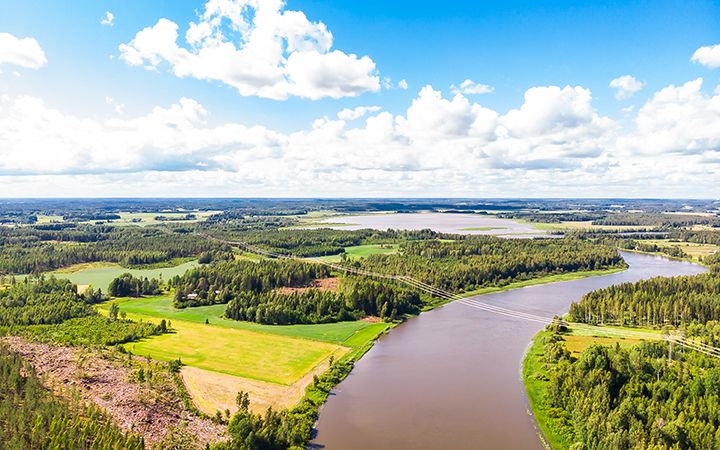Carbon neutrality is still achievable for Finland – immediate and decisive action on clean technology and land use is needed
New long-term climate scenarios demonstrate that Finland is positioned well to achieve carbon neutrality after 2040 and become carbon negative by mid-century. Reaching this goal requires strengthening both technologically and naturally produced carbon sinks. A report by VTT Technical Research Centre of Finland, the Finnish Environment Institute (SYKE), the Natural Resources Institute Finland (Luke), and the Geological Survey of Finland GTK also reveals that citizens and companies alike are highly committed to achieving climate targets.

Four different scenarios have been developed to support Finland’s long-term climate policy. These outline four diverging pathways on greenhouse gas emissions and carbon sinks.
“The results are not forecasts, but alternative future pathways. We wanted to test different actions and measures Finland could employ to achieve its long-term climate goals,” says Tiina Koljonen, Principal Scientist at VTT.
The scenarios focus on 2050. By that time emissions must be reduced by at least 90% relative to levels in 1990, per Finland’s Climate Act. Finland should also have achieved carbon negativity by that point, meaning that carbon sinks should exceed greenhouse gas emissions. According to Finland’s Climate Act, Finland should be carbon neutral by 2035 at the latest. The scenarios indicate that Finland can reach carbon neutrality after 2040 and carbon negativity by mid-century, but only if all emission sectors – industry, agriculture, energy, transport, and land use – contribute actively to the results. The land use sector faces significant challenges: predicting the factors that influence forest utilization and carbon sink development is difficult, and there are uncertainties related to the sector’s emission and sink estimates.
“The impact assessment of new climate and energy policies tells us that Finland cannot achieve carbon neutrality by 2035 with existing or the additional measures proposed by the government. However, carbon neutrality is very feasible in the long term. It requires political guidance, investment decisions within the next decade, and consistent efforts using both technical and natural carbon sinks,” Koljonen explains.
Forest carbon sinks are the Achilles’ heel of Finland
Although emissions from the emissions trading sector have fallen rapidly in recent years and the country is phasing out from fossil fuels at record speeds, Finland will not meet its climate goals without carbon dioxide removal from atmosphere, i.e. net-negative solutions. These include natural carbon sinks – such as forest biomass and soil carbon – and technical sinks, where biogenic carbon dioxide is captured and stored permanently. Both are needed alongside emission reductions to offset remaining emissions from sectors like transport, agriculture, and residential heating.
The net sink from land use, land use change and forestry (LULUCF) has weakened significantly in recent years.
Tarja Silfver, Senior Researcher at Luke, emphasises that the balance between forest use and carbon stock is crucial.
“If harvesting remains high, the forest carbon sink will remain small. Sinks can be strengthened by changing forest management practices, but it’s a slow process –decisions must be made immediately,” Silfver says.
Technological solutions are advancing, but we need more pace
According to the report, bioenergy with carbon capture and storage (BECCS) could become a key measure in the 2040s. The use of captured carbon dioxide for industrial purposes (CCU) is also important, but as emissions are usually released back into the atmosphere rather quickly, emission targets cannot be met without the permanent storage of biogenic carbon.
So far, the deployment of technical carbon sinks has been limited by investment costs, lack of policy measures, permitting processes, and insufficient carbon dioxide transport infrastructure. The scenarios show, however, that large-scale use of CCS technology could reduce Finland’s total annual emissions by several million tonnes by 2050.
Citizens support climate goals but shun significant changes in consumer behaviour
Achieving climate goals in the long run requires structural changes across society and a shift in attitudes and norms towards more sustainable consumption.
In a citizen survey conducted as part of the KEITO project, two out of three respondents (68%) considered reducing greenhouse gas emissions an important goal, and 58% believed Finland should stick to its national Climate Act targets.
“Public support remains strong, but motivations have become more complex than before,” says Sampo Soimakallio, Principal Scientist at the Finnish Environment Institute. “Key ambitions alongside climate action now include reducing our dependence on Russia, halting biodiversity loss, and increasing energy self-sufficiency.”
According to the survey, Finns feel they have already taken meaningful steps: reducing consumption and food waste, altering their diets, and recycling more. However, the willingness to make greater shifts in lifestyle – such as adopting a fully vegan diet or purchasing an all-electric car – is significantly lower.
Finland needs a vision
The KEITO project also analysed the low-carbon roadmaps of various industrial federations. Corporate commitment to climate goals is strong, but policy instruments still fall short of what is needed to drive investments.
“Companies want to invest in low-carbon solutions, but they also need predictability and clear signals of political guidance,” Koljonen notes. “Technology can take us far, but it’s not enough without political support.”
To strengthen both natural and technological sinks, faster and more impactful measures are required than those currently planned by the government.
“Major investments in research, development, and innovation are crucial drivers for progress alongside the deployment of new technologies. We must also ensure that the transition is fair across different socioeconomic groups, regions, and generations, and that negative environmental impact is minimised,” Koljonen notes.
“Finland needs a clear long-term vision and a uniformly accepted pathway towards it. Only then can we ensure that the country’s long-term climate goals will be achieved.”
The KEITO Research Project
New Actions and Scenarios for National Energy and Climate Policy (KEITO) is a joint research project by the Finnish Environment Institute (SYKE), VTT, the Geological Survey of Finland GTK, and the Natural Resources Institute Finland (Luke). The project was conducted as part of the European Union’s NextGenerationEU-funded initiatives “Clean Energy System Transition (Syke, VTT, and GTK’s REPower-CEST) and “Solutions to the challenges and opportunities of the energy transition” (REPower project by Luke). The research project supports the government’s energy and climate strategy as well as the long-term climate plan under the Climate Act.
Further information
Tiina Koljonen (alternative pathways to carbon neutrality, energy system and emissions development)
Principal Scientist, VTT
+358 50 359 9549, tiina.koljonen@vtt.fi
Tarja Silfver (agriculture and land use sector development)
Senior Researcher, Luke
+358 29 532 2555, tarja.silfver@luke.fi
Sampo Soimakallio (environmental impacts and public acceptance)
Principal Scientist, Finnish Environment Institute (SYKE)
+358 29 525 1803, sampo.soimakallio@syke.fi
Keywords
Contacts
Media service at Finnish Environment Institute
Our Media Service provides information on research, helps journalists find experts for interviews and provides photos for media use.
Our Communication experts will answer your inquiries on weekdays from 9 am to 4 pm.
Finnish Environment Institute - We build hope through research.
Finnish Environment Institute
Latokartanonkaari 11
00790 Helsinki
+358 295 251 000
It is time to move beyond solving environmental problems one by one, to systemic sustainability transformations. The Finnish Environment Institute (Syke) contributes to building a sustainable society through research, information and services. The Finnish Environment Institute is a research institute with 700 experts and researchers located in Helsinki, Oulu, Jyväskylä and Joensuu.

Subscribe to releases from Suomen ympäristökeskus
Subscribe to all the latest releases from Suomen ympäristökeskus by registering your e-mail address below. You can unsubscribe at any time.
Latest releases from Suomen ympäristökeskus
Ennallistamista tarvitaan järvien ja virtavesien heikentyneen lajiston elvyttämiseksi31.10.2025 08:40:00 EET | Tiedote
Suomen järvien ja virtavesien lajiston monimuotoisuuden tilaa on arvioitu ensimmäistä kertaa koko Suomen tasolla ja alueellisesti. Tulosten mukaan sisävesien lajisto on merkittävästi heikentynyt. Muutokset ilmenevät erityisesti alueellisena lajikatona. Monimuotoisuutta olisi kuitenkin mahdollista turvata ennallistamissuunnitelman avulla. Uudet tulokset tarjoavat keskeisen tietopohjan ennallistamisen tueksi.
Viikkokatsaus 3.–7.11.202530.10.2025 12:12:00 EET | Tiedote
Hei! Tässä tiedoksesi meillä Suomen ympäristökeskuksessa ensi viikolla ilmestyviä tiedotteita, uutisia, kampanjoita, blogeja ja uutiskirjeitä. Mukana myös tulevia tapahtumia ja webinaareja. Jakelemme viikkokatsauksen torstaisin STT:n kautta. Koosteet löytyvät myös STT-uutishuoneesta, josta voit tilata kaikki Suomen ympäristökeskuksen tiedotteet.
Entiset turvetuotantoalueet kosteikoiksi — luonto ja ilmasto kiittävät30.10.2025 07:50:00 EET | Tiedote
Käytöstä poistuneen turvetuotantoalueen vesittäminen kosteikoksi parantaa luonnon monimuotoisuuttaa ja voi vähentää vesistö- ja ilmastopäästöjä selvisi tutkimushankkeessa, jossa tarkasteltiin turvetuotantoalueiden jatkokäyttöä Pohjois-Pohjanmaalla.
Yhteistyöstä voimaa virkistyskäytön suunnitteluun29.10.2025 08:05:00 EET | Tiedote
Luonnon virkistyskäyttö tulisi huomioida tasavertaisena osana alueiden käytön kokonaisuutta suunnittelun eri tasoilla.
Finnish municipalities have progressed to varying degrees in climate change adaptation – risks are not sufficiently assessed28.10.2025 06:00:00 EET | Press release
The majority of Finnish municipalities have taken action to adapt to climate change. However, only less than half of the municipalities have set targets or prepared action plans for climate change adaptation, reveals a recent survey conducted by the Finnish Environment Institute (Syke).
In our pressroom you can read all our latest releases, find our press contacts, images, documents and other relevant information about us.
Visit our pressroom